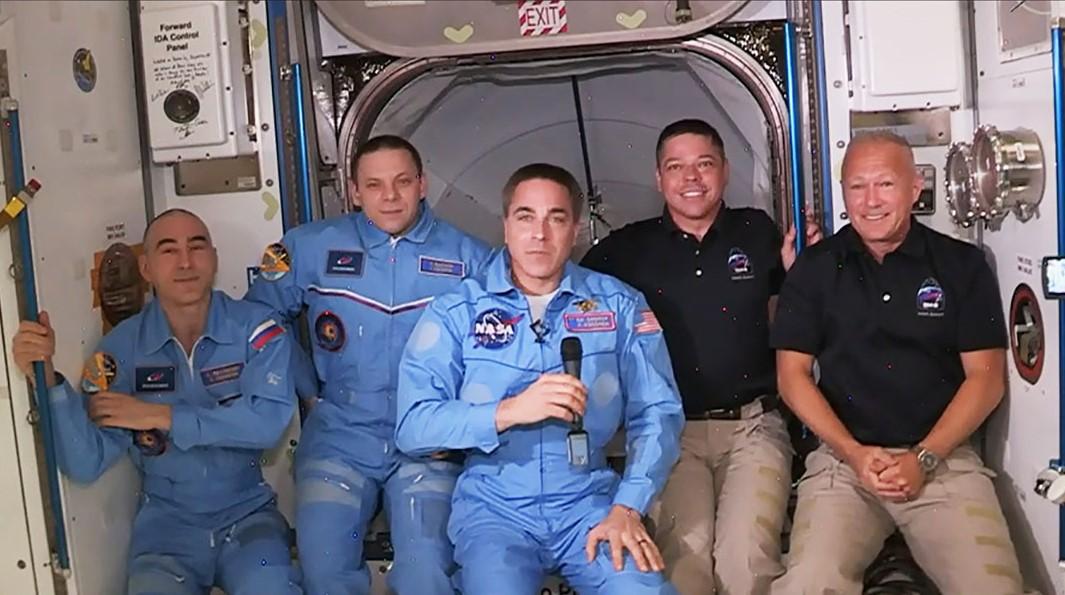
HOUSTON—NASA astronauts Doug Hurley and Bob Behnken offered praise to SpaceX and their agency colleagues June 1, as their first full day aboard the International Space Station (ISS) got underway following their historic May 30 launch.
“Things worked exactly the way we expected them to work. It’s a pretty awe-inspiring trip so far, pretty humbling,” Hurley told Benjamin Reed, SpaceX’s Commercial Crew Program manager in a brief exchange.
The veteran astronauts’ Commercial Crew Program Demo-2 test flight will have them living and working aboard the orbiting science lab for up to four months. Their Crew Dragon capsule docked with the ISS on May 31 at 9:27 a.m. EDT.
Hurley and Behnken each flew two previous space shuttle missions as part of the lengthy assembly of the ISS. They compared the launch experiences in a news briefing prior to the exchange with Reed at SpaceX headquarters in Hawthorne, California. The astronauts’ assessment may serve to assure NASA it will have at least one commercial means of transporting astronauts to and from Earth orbit, a capability the nation lost when the agency’s space shuttle fleet was retired in July 2011.
The shuttle, Hurley and Behnken noted, lifted off with the help of a pair of solid rocket boosters that fired for 2 1/2 min. before separating, leaving the winged orbiter’s three liquid hydrogen and oxygen main engines to power the rest of the nine-minute ascent.
The Falcon 9/Crew Dragon experience was almost the opposite. “The first stage with the Falcon 9 with the nine Merlin engines was a much smoother ride, obviously, because it was a liquid engine ascent,” Hurley said of the core stage’s rocket-grade kerosene (RP-1) and liquid oxygen propellants.
“Where the difference started for both Bob and I was at staging. The first stage engines shut off. Then it takes almost a second between the booster separating and the second stage Merlin vacuum engine starting” he continued. “At that point, we go roughly from three G’s to zero G for half a second probably. Then when the [single] Merlin vacuum engine fires we start to accelerate again for the next five to six minutes until we achieve orbit. It was totally different from the shuttle. It was smooth, then it got a little rougher.”
The astronauts compared notes between themselves throughout the ride to orbit.
“Doug and I both commented we felt some early zero G when we came off the first stage and were getting ready to transition to the second stage,” Behnken said.
Like those who launched on the shuttle, Hurley and Behnken wore distinctive Crew Dragon spacesuit that were white and custom fitted, versus orange and off the shelf. In each case, the suits are meant to be worn primarily during launch and atmospheric re-entry to protect the astronauts in the event of a pressure loss inside the crew compartment.
“I bet we have donned and doffed those suits a couple of hundred times,” Behnken said. “They are custom designed and fitted, so they are very comfortable. They are much easier to get in and out of in zero G, as we figured out over the two days. We complimented the suit team. They worked very well and were everything we expected going uphill.”
While the astronauts settle into their new home, NASA’s ISS program managers here at the Johnson Space Center in Houston will be evaluating how long the two men will remain and the tasks they will perform. The Demo-2 Crew Dragon is limited to about four months by its power-generating solar panels.
During their first full day, Hurley and Behnken joined fellow NASA astronaut and ISS Commander Chris Cassidy and cosmonauts Anatoly Ivanishin and Ivan Vagner for the unloading of a modest cargo delivered on the Crew Dragon and a much larger cargo that arrived aboard the Japan Aerospace Exploration Agency’s (JAXA) HTV-9 resupply capsule on May 25.
“They are already hitting the ground running,” Cassidy said of his new crewmates. Working with NASA’s Mission Control, Hurley and Behnken will be assigned activities in support of dozens of science investigations and technology demonstrations underway or slated to get underway on the ISS.
Until the Demo-2 duo arrived, ISS managers only could count on one NASA astronaut and two cosmonauts being on board for the foreseeable future, rather than the typical six to seven men and women. Until recently, Cassidy held the last NASA-purchased seat for launch on a three-person Russian Soyuz spacecraft, the only means of transportation to and from the ISS until Demo-2 lifted off. Cassidy arrived at the ISS aboard the Soyuz spacecraft on April 9 with Ivanishin and Vagner.
In addition to the science experiments, there is everyday maintenance and the prospect for spacewalks with the arrival of Hurley and Behnken. The HTV-9’s cargo included a final set of six external lithium-ion (Li) solar power storage batteries. NASA is eager to install the Li batteries in place of a dozen aging nickel hydrogen (NH) batteries on the station’s solar power truss. Three similar swap-outs involving several spacewalks each were carried out at power channels distributed on the 360-ft.-long power truss in January 2017, March 2019 and October 2019 through January 2020.
“We don’t just sit up here at dinner and decide when all those activities will be done,” Cassidy said. “The prioritization is done in Houston. Then we execute the plan. So the three of us are pretty excited to get after it together.”
Some of the decision making yet to come involves how long the newcomers will remain aboard the ISS. If the Demo-2 Crew Dragon checks out on orbit as successfully as it appears to have launched, Hurley and Behnken could return to Earth in several weeks so that NASA can complete SpaceX certification to launch the Crew-1 Dragon mission in late August with four NASA and Japanese astronauts.





